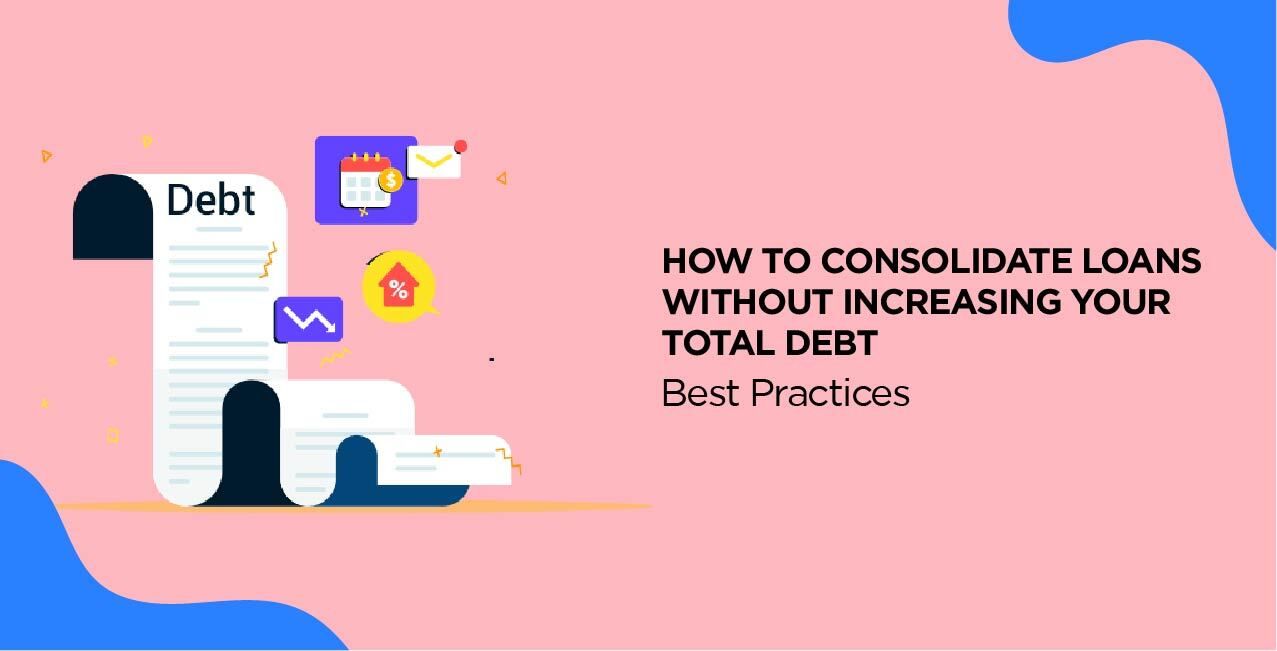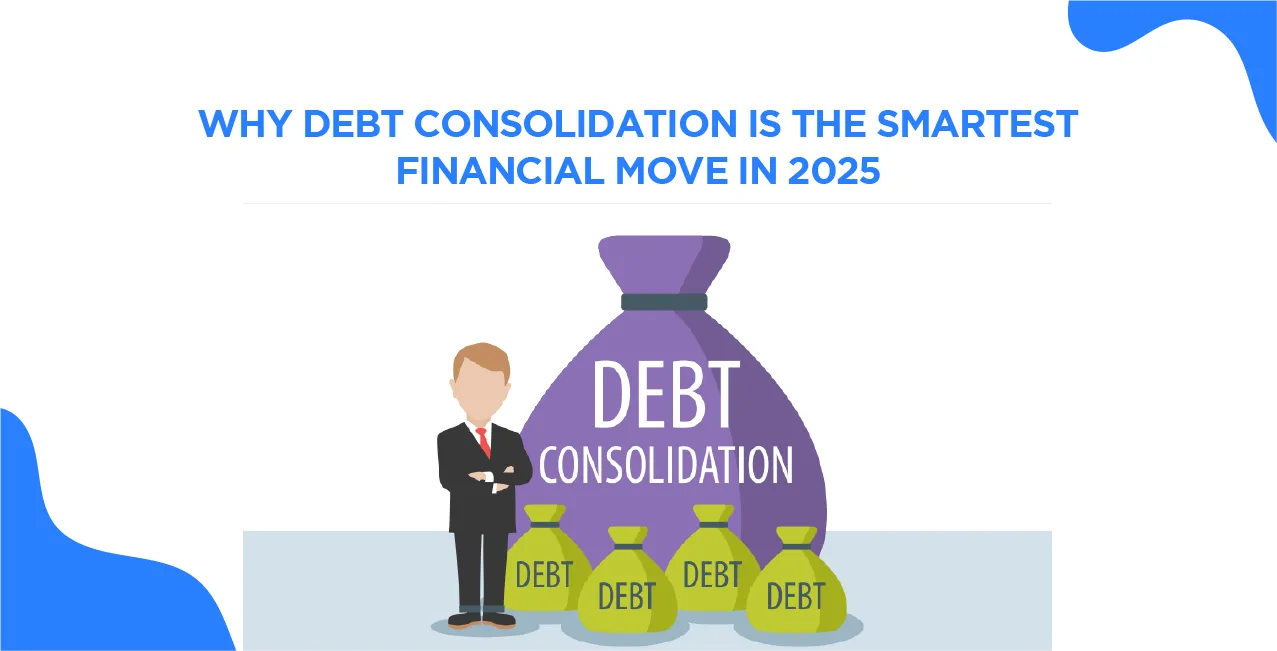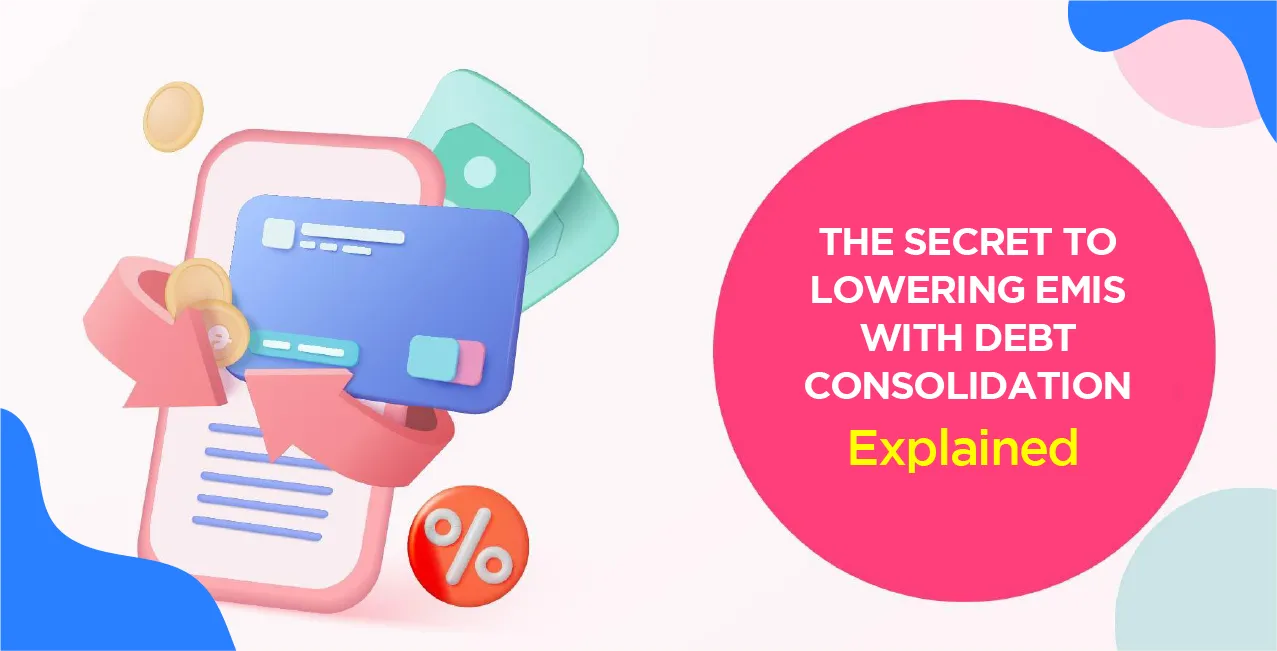
Author
LoansJagat Team
Read Time
8 Min
02 Apr 2025
How to Consolidate Loans Without Increasing Your Total Debt – Best Practices
Rahul, a 32-year-old IT professional from Bengaluru, had multiple loans: a car loan of ₹5,00,000, a personal loan of ₹2,00,000, and credit card debt amounting to ₹1,50,000. Managing different interest rates and due dates became overwhelming, leading to missed payments and mounting stress.
Rahul's situation is not unique. As of June 2024, India's household debt stood at 42.9% of the GDP, reflecting a significant rise over the past three years. Many individuals like Rahul are exploring loan consolidation to streamline their finances.
But how can one consolidate loans without increasing the total debt burden? Keep reading to find out.
What Is Loan Consolidation and How It Works?
Rahul, a software engineer from Pune, had multiple loans: a personal loan of ₹2,50,000, a car loan of ₹4,00,000, and a credit card debt of ₹1,00,000. Managing different EMI dates and high interest rates made his finances stressful.
He opted for loan consolidation to simplify payments but later realised that choosing the wrong plan could lead to even more financial trouble.
Loan consolidation is merging multiple loans into one, ideally with a lower interest rate or a better repayment term.
The goal is to make debt repayment easier and more affordable. However, not all consolidation plans are beneficial, and some may increase total debt if not chosen wisely.
Types of Loan Consolidation:
Type | How It Works | Best For |
Personal Loan Consolidation | Combines multiple debts into one lower-interest personal loan | Those with multiple high-interest loans |
Credit Card Balance Transfer | Moves high-interest credit card debt to a 0% APR card | Borrowers who can pay off debt within the promotional period |
Debt Management Plan | Financial counsellors negotiate structured repayment plans with lenders | People struggling with unsecured loans |
How Loan Consolidation Can Go Wrong?
- Extending the loan tenure increases the total interest paid.
- Some lenders charge high processing fees, making consolidation costly.
- A secured loan for unsecured debt risks losing assets like a home or car.
Why Many Borrowers End Up with More Debt After Consolidation?
Many borrowers feel relieved after consolidating loans, but without careful planning, they end up in deeper debt. Consolidation may lower EMIs, but it does not erase debt—it only restructures it. Poor financial habits can turn consolidation into a financial trap.
False Sense of Financial Relief
After consolidating multiple loans, borrowers feel like they have more financial freedom. This illusion leads them to take on new loans or increase spending, pushing them back into a cycle of debt.
Longer Repayment Terms with Higher Interest Paid
A lower EMI does not mean a cheaper loan. Extending loan tenure from 5 to 10 years reduces monthly payments but increases the total interest paid. For example, a ₹1,00,000 loan at 12% interest for 5 years costs ₹33,347 in total interest. If extended to 10 years, the interest paid becomes ₹69,735.
Hidden Fees That Increase the Total Debt
Many borrowers do not check processing fees, foreclosure charges, and prepayment penalties. Some lenders add hidden costs that make consolidation more expensive than keeping multiple loans.
Converting Unsecured Loans into Secured Debt
Some borrowers consolidate unsecured debt (like credit cards) using secured loans (like home loans). This puts assets like houses or cars at risk. If they default, they lose valuable property.
Borrowing More Than Necessary
Consolidation loans often allow borrowers to borrow additional amounts. Many borrow more than is required, leading to unnecessary debt.
The Right Way to Consolidate Loans Without Increasing Debt
Step 1: Assess Your Total Debt and Interest Rates
Before choosing a consolidation option, calculate all existing loans, their interest rates, monthly EMIs, and remaining balances. Identify which loans have high interest and which can be consolidated for better terms.
Loan Type | Amount | Interest Rate | EMI |
Personal Loan | ₹2,00,000 | 14% | ₹43,663 |
Car Loan | ₹4,50,000 | 10% | ₹89,050 |
Credit Card Debt | ₹1,50,000 | 36% | ₹46,000 |
Step 2: Choose the Best Loan Consolidation Strategy
- Debt Snowball vs. Debt Avalanche Approach: Pay off small debts first for motivation (Snowball) or clear high-interest loans for savings (Avalanche).
- Low-Interest Personal Loans: These loans are used to repay high-interest debts.
- Balance Transfer Cards: Good if you can clear the balance within 6-12 months of the promotional period.
- Debt Consolidation Loans vs. Home Equity Loans: Use home equity loans only if you can manage secured debt responsibly.
- Government-Backed Loans: Look for student loan or mortgage consolidation programs.
Step 3: Compare Lenders and Consolidation Loan Offers
Before selecting a lender, compare the following factors:
Factor | What to Check |
Interest Rate | Fixed vs. variable rate loans |
Loan Tenure | Longer tenure = more interest paid |
Prepayment Charges | Some lenders charge fees for early repayment |
Customer Reviews | Check lender reputation and service quality |
Step 4: Stick to a Strict Budget and Avoid New Debt
After consolidating your loans, focus on financial discipline to avoid further debt problems.
- Limit unnecessary expenses and avoid lifestyle inflation.
- Maintain a high credit score by paying EMIs on time.
- Automate EMI payments to prevent missed deadlines.
- Avoid taking new loans until existing ones are cleared.
- Create an emergency fund for unexpected expenses.
- Track spending to ensure financial stability.
- Keep credit utilisation below 30% to maintain a good CIBIL score.
Loan consolidation can simplify finances, but only if done wisely. Selecting the right strategy and following disciplined financial habits can help borrowers regain control of their debt without falling into another financial trap.
Read More – How to Get Started with Debt Consolidation at LoansJagat?
Alternative Solutions to Consider Before Consolidation
Many people jump to loan consolidation without exploring better alternatives. While consolidation can simplify payments, it is not always the best solution.
Some borrowers can reduce their debt burden by negotiating with lenders, refinancing individual loans, or seeking financial guidance. Before committing to consolidation, consider these alternatives that might work better for your financial situation.
1. Debt Settlement: Negotiating with Creditors for Lower Repayments
If you are struggling with high debt, negotiating directly with lenders can help reduce the total amount owed. Many lenders agree to settle a loan for a lower amount if the borrower makes a lump-sum payment.
For example, if Rahul owes ₹3,00,000 on a credit card but cannot afford the full amount, he may negotiate with the bank to pay ₹2,40,000 as a one-time settlement. This reduces the burden but may temporarily impact his credit score.
2. Refinancing Individual Loans Instead of Consolidating Everything
Instead of consolidating multiple loans, refinancing a high-interest loan into a lower-interest one can save money.
For example, a person paying 18% interest on a personal loan of ₹5,00,000 can refinance it at 12%, significantly lowering EMIs. This is particularly useful for home, car, and business loans.
Comparison Between Refinancing and Consolidation
Factor | Refinancing | Loan Consolidation |
Purpose | Lower interest on a single loan | Merging multiple loans into one |
Interest Rate Change | Reduces for one loan | It may or may not reduce overall |
Impact on Credit Score | Slightly improves if paid on time | It may initially drop but improve later |
Best for | Home, car, or personal loans | People with multiple high-interest loans |
3. Seeking Credit Counseling for a Structured Debt Repayment Plan
Financial counselling can help borrowers understand how to repay debt without worsening their situation. Many non-profit credit counselling agencies in India assist individuals in creating a structured plan.
If Rahul is struggling with ₹7,00,000 in loans, a counsellor may suggest a repayment plan where he clears smaller debts first before tackling bigger ones.
4. Building an Emergency Fund to Avoid New Debt
Many people take new loans when facing unexpected expenses. Instead of relying on loans, having an emergency fund can prevent new debt accumulation.
Experts recommend saving at least three to six months' worth of expenses. For instance, if Rahul’s monthly cost is ₹50,000, he should aim to have at least ₹1,50,000 in a savings account.
Common Myths About Debt Consolidation and the Truth
Many borrowers misunderstand how loan consolidation works, leading to financial mistakes. Here are some common myths and the truth behind them.
Myth 1: Consolidating Loans Always Saves Money
Truth: Loan consolidation only works if you get a lower interest rate and a shorter repayment. If you extend the tenure to reduce monthly EMIs, you may pay more in interest over time.
For example, a ₹5,00,000 loan at 14% for 5 years will cost ₹1,95,000 in interest. If extended to 10 years, the total interest will rise to ₹4,20,000—more than double.
Myth 2: All Debt Consolidation Loans Are the Same
Truth: Lenders offer different terms, processing fees, and repayment conditions. A bank may charge 10% interest, while an NBFC
may offer 12%. Some lenders have hidden charges that increase the cost of consolidation.
Also Read - Why Debt Consolidation is a Game-Changer in Managing EMIs
Myth 3: Loan Consolidation Always Affects Credit Score Negatively
Truth: While applying for a new loan may temporarily dip your credit score, proper management can improve it over time. Paying
EMIs on time and reducing total debt can boost your credit score.
Other Myths About Debt Consolidation
- Myth: Consolidation eliminates debt faster.
Truth: It only restructures debt; repayment still depends on financial discipline. - Myth: Only people in deep financial trouble consolidate loans.
Truth: Many financially stable individuals consolidate to manage payments better. - Myth: You cannot consolidate unsecured debt.
Truth: Personal and credit card debts are often consolidated through balance transfers or personal loans.
This section uses simple language, includes real examples, and presents the content in an easy-to-read format. Let me know if you need any changes!
Conclusion
Loan consolidation can simplify your financial life, but it is not a magic fix for debt. If done wisely, it helps reduce interest costs and manage EMIs better. However, if you don’t control spending or choose the wrong loan terms, it can lead to more debt in the long run.
Before consolidating, assess your current debts, compare lender options, and pick a strategy that fits your financial situation. More importantly, focus on financial discipline—stick to a budget, avoid new loans, and build an emergency fund.
FAQs
1. Does loan consolidation reduce my total debt?
No, it does not reduce your debt; it only merges multiple loans into one. You must still repay the full amount, but ideally at a lower interest rate.
2. Will consolidating my loans affect my credit score?
Yes, initially, your credit score may drop slightly. However, your score will improve over time if you make regular EMI payments.
3. Is it better to take a personal loan or a balance transfer for consolidation?
It depends on your debt type. Personal loans work for high-interest loans, while balance transfer cards are better for short-term credit card debt relief.
4. Can I consolidate secured and unsecured loans together?
Yes, but be cautious. Converting unsecured debt (like credit cards) into secured loans (like a home loan) puts assets at risk if you default.
5. What should I check before choosing a debt consolidation lender?
Compare interest rates, loan tenure, prepayment charges, and lender reputation. Always check for hidden fees before signing the agreement.
About the Author

LoansJagat Team
‘Simplify Finance for Everyone.’ This is the common goal of our team, as we try to explain any topic with relatable examples. From personal to business finance, managing EMIs to becoming debt-free, we do extensive research on each and every parameter, so you don’t have to. Scroll up and have a look at what 15+ years of experience in the BFSI sector looks like.

Quick Apply Loan
Subscribe Now
Related Blog Post


